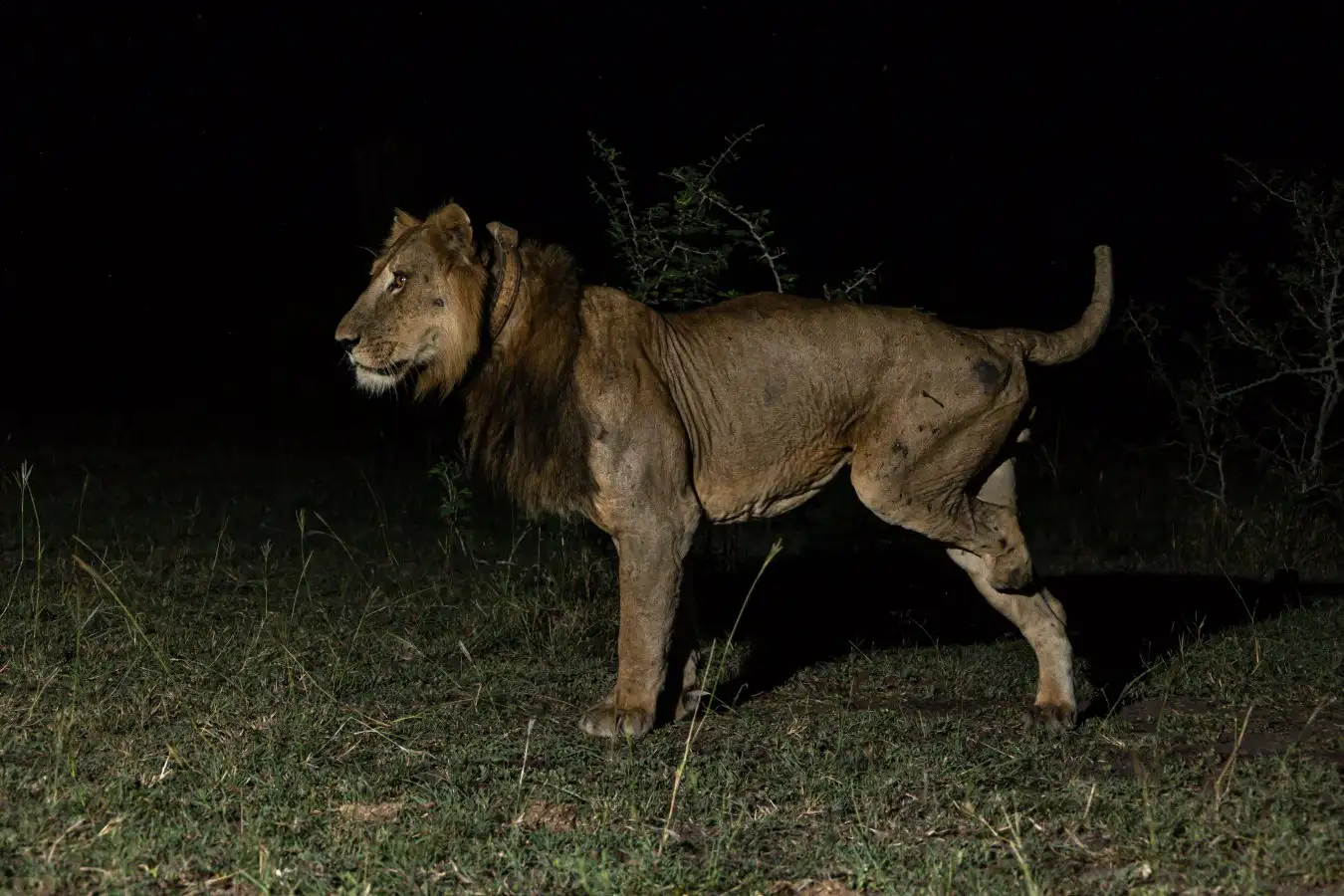
Jacob, outfitted with a tracking collar, lost his left hind leg in a poacher’s snare
Alex Braczkowski
A lion that lost one leg to a poacher’s snare has defied the expectations of conservation scientists by adopting an inventive new hunting strategy.
Jacob, an 11-year-old lion in Queen Elizabeth National Park, Uganda, made headlines last year when he and his brother were filmed swimming 1.5 kilometres across a crocodile-filled river, the longest swim ever recorded in their species.
Wounded carnivores usually scavenge, take cattle or rely on a pride for food if they are lucky, but Jacob, who is also missing an eye after being gored by a water buffalo, has only his brother Tibu to support him.
Researchers were convinced that he would starve after he lost his left hind leg in 2020. “Instead, he refuses to quit,” says Alexander Braczkowski at the Kyambura Lion Monitoring Project, which is supported by the Volcanoes Safari Partnership Trust, a Ugandan NGO focused on conservation and community development.
Even Braczkowski, who has studied Jacob since 2017, was puzzled by his survival. But now thermal drone footage has revealed his secret: this lion has learned to act like a leopard.
Since he can’t overpower prey as lions typically do, Jacob sets close-range ambushes in dense thickets and scrub forests, lying in wait and pouncing, or digging his prey out.
He is also targeting prey lions normally don’t hunt, Braczkowski says. Filming at night, he captured Jacob hunting 200-kg forest hogs, making kills both alone and alongside his brother.
“Jacob can’t sprint, so he doesn’t have a chance to chase prey,” Braczkowski says. “Because he’s targeting a very specific pig, it tells us he made a dietary shift. That’s also why he’s acting more like a leopard and taking big risks. But he has to – and it’s working.”
Losing limbs to snares is “common” for felines, says Andrew Loveridge of Panthera, a global wild cat conservation organisation.
Jacob and his brother Tibu, both wearing tracking collars
Alex Braczkowski
So is adapting, adds Craig Packer at the University of Minnesota, who has studied lion behavior for decades. “I’d expect to see similar behaviour in other groups of lions,” he says, “all of which had four good legs, in the same area.”
But that’s not happening here, points out Braczkowski, who says Queen Elizabeth’s lions focus on large, fast-moving game like antelopes and water buffalo.
“Lions do behave like leopards at times and go up in trees,” says George Schaller, whose 1960s fieldwork on Serengeti lions was the first major study on predator-prey relationships.
But even arboreal lions maintain distinctive hunting styles, and lions without limbs, so-called tripod lions, are usually kept alive by a pride, Schaller adds.
Braczkowski has now tracked Jacob making the long swim across the Kazinga Channel between 10 and 20 times over the past two years. His daily movement of 1.73 kilometres on average – less than a healthy lion but quite far for an injured animal – may be driven by a lack of suitable prey or the need to find mates, he says.
Jacob’s novel hunting strategy may be teachable behaviour that could help reverse declining lion numbers in a region facing habitat loss, climate change, and encroaching communities. That is why Jacob is important, “symbolically and genetically,” says Braczkowski.
This individual lion is a testament to survival, adds Schaller: “They’re a species of fighters.”
Conservation and rewilding in the Central Apennines: Italy
Journey into Italy’s Central Apennines region for a fascinating introduction to the concept and practicalities of rewilding.
Topics:
Source link : https://www.newscientist.com/article/2503282-a-three-legged-lion-has-learned-to-hunt-in-a-completely-unexpected-way/?utm_campaign=RSS%7CNSNS&utm_source=NSNS&utm_medium=RSS&utm_content=home
Author :
Publish date : 2025-11-06 18:00:00
Copyright for syndicated content belongs to the linked Source.